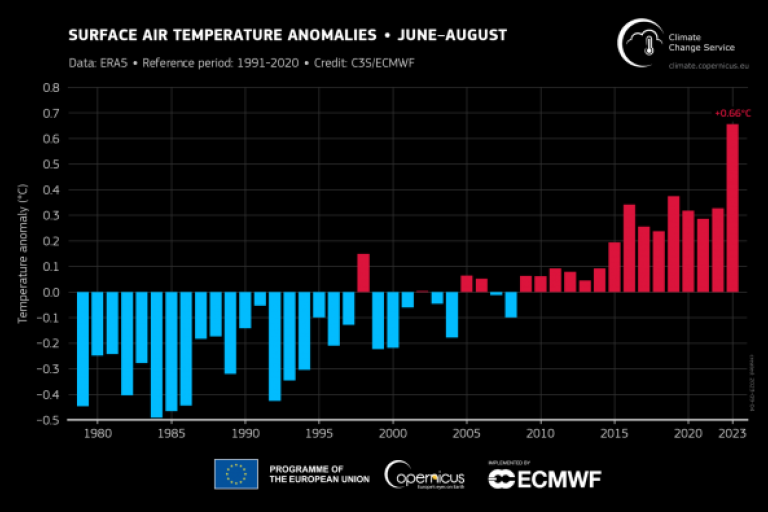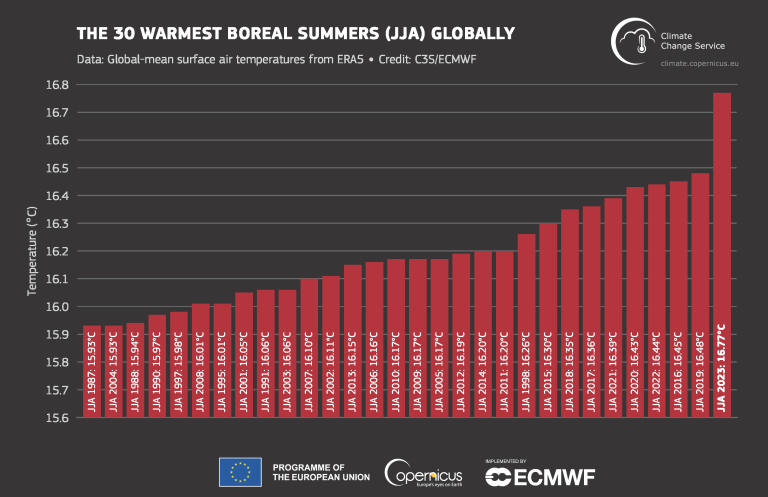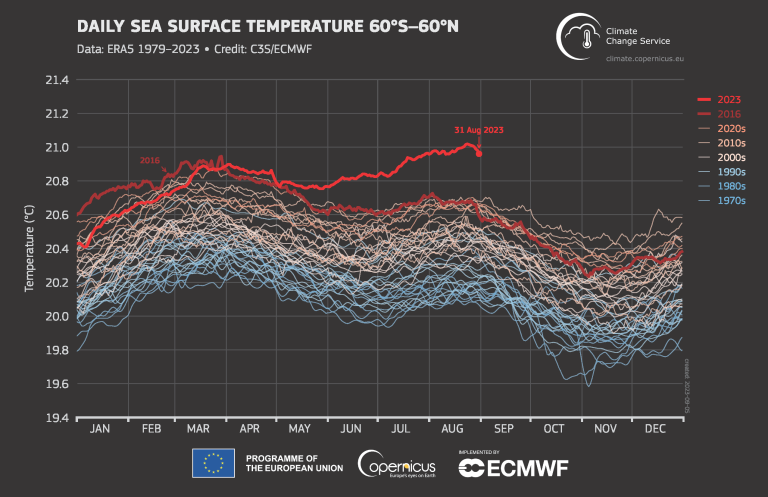Earth had hottest three-month period on record, with unprecedented sea surface temperatures and much extreme weather
Bonn and Geneva - Earth just had its hottest three months on record, according to the European Union-funded Copernicus Climate Change Service (C3S) implemented by ECMWF. Global sea surface temperatures are at unprecedented highs for the third consecutive month and Antarctic sea ice extent remains at a record low for the time of year.
- Published in partnership with:
- European Centre for Medium-Range Weather Forecasts (ECMWF)

It was the hottest August on record – by a large margin – and the second hottest ever month after July 2023, according to the Copernicus Climate Change Service ERA 5 dataset. August as a whole is estimated to have been around 1.5°C warmer than the preindustrial average for 1850-1900, according to the C3S monthly climate bulletin.
The year so far (January to August) is the second warmest on record behind 2016, when there was a powerful warming El Niño event.
August as a whole saw the highest global monthly average sea surface temperatures on record across all months, at 20.98°C. Temperatures exceeded the previous record (March 2016) every single day in August.
Antarctic sea ice extent remained at a record low level for the time of year, with a monthly value 12% below average, by far the largest negative anomaly for August since satellite observations began in the late 1970s. Arctic sea ice extent was 10% below average, but well above the record minimum of August 2012.
WMO consolidates data from C3S and five other international datasets for its climate monitoring activities and its State of the Climate reports.
A report in May from WMO and the UK's Met Office predicted that there is a 98% likelihood that at least one of the next five years will be the warmest on record and a 66% chance of temporarily exceeding 1.5°C above the 1850-1900 average for at least one of the five years. This does not mean that we will permanently exceed the 1.5°C level specified in the Paris Agreement which refers to long-term warming over many years.

Commentary
“Our planet has just endured a season of simmering -- the hottest summer on record. Climate breakdown has begun. Scientists have long warned what our fossil fuel addiction will unleash. Surging temperatures demand a surge in action. Leaders must turn up the heat now for climate solutions. We can still avoid the worst of climate chaos – and we don’t have a moment to lose, “ said UN Secretary-General António Guterres.
“The northern hemisphere just had a summer of extremes – with repeated heatwaves fuelling devastating wildfires, harming health, disrupting daily lives and wreaking a lasting toll on the environment. In the southern hemisphere Antarctic sea ice extent was literally off the charts, and the global sea surface temperature was once again at a new record. It is worth noting that this is happening BEFORE we see the full warming impact of the El Niño event, which typically plays out in the second year after it develops” says World Meteorological Organization Secretary-General Prof. Petteri Taalas.
“Eight months into 2023, so far we are experiencing the second warmest year to date, only fractionally cooler than 2016, and August was estimated to be around 1.5°C warmer than pre-industrial levels. What we are observing, not only new extremes but the persistence of these record-breaking conditions, and the impacts these have on both people and planet, are a clear consequence of the warming of the climate system,” comments Carlo Buontempo, Director of the Copernicus Climate Change Service, ECMWF.

Notes to Editors
C3S, implemented by the European Centre for Medium-Range Weather Forecasts (ECMWF) on behalf of the European Commission, routinely monitors climate and has also been closely following recent development of global air and sea surface temperatures. The monthly report and associated assets is here.
More information on the sea surface temperatures in August 2023 can be found here.
More information about climate variables in August and climate updates of previous months as well as high-resolution graphics and the video can be downloaded here.
Answers to frequently asked questions regarding temperature monitoring can be found here.
The World Meteorological Organization (WMO) is a specialized agency of the United Nations responsible for promoting international cooperation in atmospheric science and meteorology.
WMO monitors weather, climate, and water resources and provides support to its Members in forecasting and disaster mitigation. The organization is committed to advancing scientific knowledge and improving public safety and well-being through its work.
For further information, please contact:
- Clare Nullis WMO media officer cnullis@wmo.int +41 79 709 13 97
- WMO Strategic Communication Office Media Contact media@wmo.int

